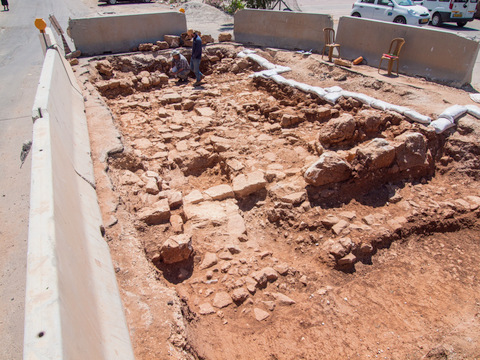According to the excavation director on behalf of the Israel Antiquities Authority, “This is the first time we have encountered such a finely preserved section of the road in Jerusalem”.

Photographic credit: Assaf Peretz, courtesy of the Israel Antiquities Authority
An ancient road leading from Yafo to Jerusalem, which dates to the Roman period (second–fourth centuries CE), was exposed this past fortnight in the Beit Hanina neighborhood in northern Jerusalem. The road remains were revealed in an archaeological excavation the IAA conducted in Beit Hanina prior to the installation of a drainage pipe by the Moriah Company.
The wide road (c. 8 m) was bounded on both sides by curbstones. The road itself was built of large flat stones fitted to each other so as to create a comfortable surface for walking. Some of the pavers were very badly worn, indicating the extensive use that was made of the road, and over the years the road also underwent a series of repairs.
According to David Yeger, excavation director on behalf of the Israel Antiquities Authority, “Several segments of the road were previously excavated by research expeditions of the IAA, but such a finely preserved section of the road has not been discovered in the city of Jerusalem until now”.
“The Romans attached great importance to the roads in the empire. They invested large sums of money and utilized the most advanced technological aids of the period in order to crisscross the empire with roads. These served the government, military, economy and public by providing an efficient and safe means of passage. Way stations and roadside inns were built along the roads, as well fortresses in order to protect the travelers. The construction and maintenance of the roads was assigned to military units, but civilians also participated in the work as part of the compulsory labor imposed on them by the authorities.”
The road section discovered in the IAA excavations in Beit Hanina is part of the imperial network of roads that led to Jerusalem from the coastal plain. We know about these roads from both historical sources and archaeological excavations. Two main arteries led from Yafo to Jerusalem during the Roman period. One is the road that passes through Bet Horon and the other runs via Shaar HaGai. This particular segment belongs to the Bet Horon road. The road began in Yafo and passed through Lod where it split it two different directions: one to Shaar HaGai and the other by way of Modiin along the route of what is today Highway 443 to Bet Horon. From there the road continued eastward as far as Bir Nabala and turned south to Kefar Shmuel where it merged with the highlands road that led to the Old City of Jerusalem.
In some places we can see that the modern Bir Nabala road was paved just a few centimeters above the route of the ancient road, which indicates that until a few decades ago the ancient road in this region was visible and was used.
Additional Articles ...